英语八大时态及被动语态
- 格式:doc
- 大小:19.50 KB
- 文档页数:1
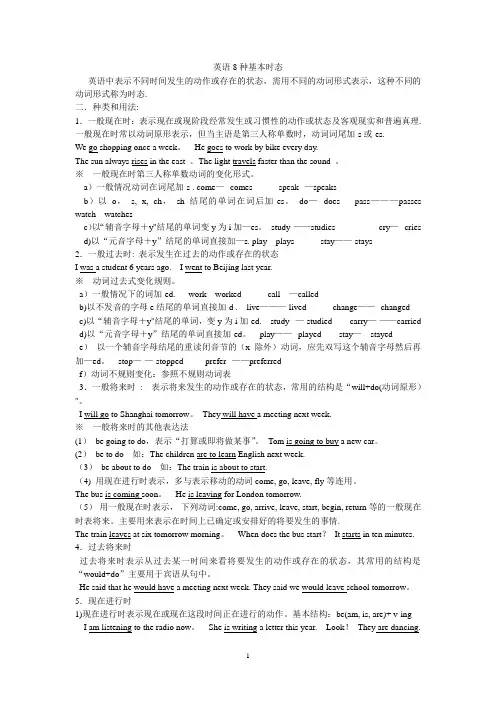
英语8种基本时态英语中表示不同时间发生的动作或存在的状态,需用不同的动词形式表示,这种不同的动词形式称为时态.二.种类和用法:1.一般现在时:表示现在或现阶段经常发生或习惯性的动作或状态及客观现实和普遍真理. 一般现在时常以动词原形表示,但当主语是第三人称单数时,动词词尾加-s或-es.We go shopping once a week。
He goes to work by bike every day.The sun always rises in the east 。
The light travels faster than the sound 。
※一般现在时第三人称单数动词的变化形式。
a)一般情况动词在词尾加-s . come—--comes speak--—speaksb)以o,s, x, ch,sh结尾的单词在词后加-es。
do—--does pass———passes watch---watchesc)以“辅音字母+y"结尾的单词变y为i加—es。
study-——studies cry—--cries d)以“元音字母+y”结尾的单词直接加—s. play---plays stay——-stays2.一般过去时: 表示发生在过去的动作或存在的状态I was a student 6 years ago. I went to Beijing last year.※动词过去式变化规则。
a)一般情况下的词加-ed. work---worked call---—calledb)以不发音的字母e结尾的单词直接加-d . live———-lived change——--changedc)以“辅音字母+y"结尾的单词,变y为i加-ed. study--—-studied carry—-——carriedd)以“元音字母+y”结尾的单词直接加-ed。
play——--played stay—---stayede)以一个辅音字母结尾的重读闭音节的(x除外)动词,应先双写这个辅音字母然后再加—ed。
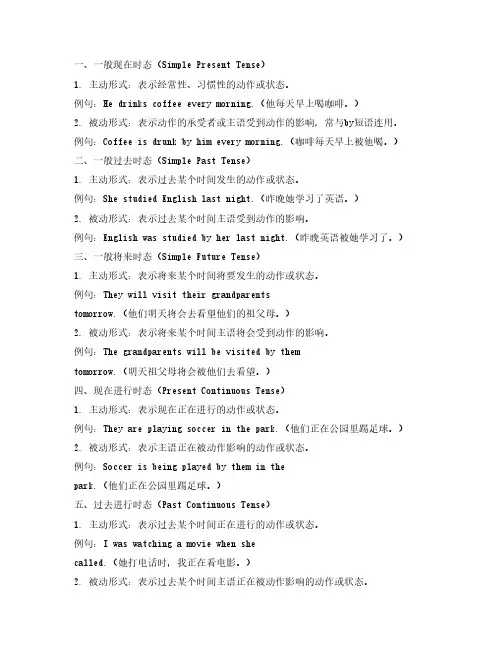
一、一般现在时态(Simple Present Tense)1. 主动形式:表示经常性、习惯性的动作或状态。
例句:He drinks coffee every morning.(他每天早上喝咖啡。
)2. 被动形式:表示动作的承受者或主语受到动作的影响,常与by短语连用。
例句:Coffee is drunk by him every morning.(咖啡每天早上被他喝。
)二、一般过去时态(Simple Past Tense)1. 主动形式:表示过去某个时间发生的动作或状态。
例句:She studied English last night.(昨晚她学习了英语。
)2. 被动形式:表示过去某个时间主语受到动作的影响。
例句:English was studied by her last night.(昨晚英语被她学习了。
)三、一般将来时态(Simple Future Tense)1. 主动形式:表示将来某个时间将要发生的动作或状态。
例句:They will visit their grandparentstomorrow.(他们明天将会去看望他们的祖父母。
)2. 被动形式:表示将来某个时间主语将会受到动作的影响。
例句:The grandparents will be visited by themtomorrow.(明天祖父母将会被他们去看望。
)四、现在进行时态(Present Continuous Tense)1. 主动形式:表示现在正在进行的动作或状态。
例句:They are playing soccer in the park.(他们正在公园里踢足球。
)2. 被动形式:表示主语正在被动作影响的动作或状态。
例句:Soccer is being played by them in thepark.(他们正在公园里踢足球。
)五、过去进行时态(Past Continuous Tense)1. 主动形式:表示过去某个时间正在进行的动作或状态。
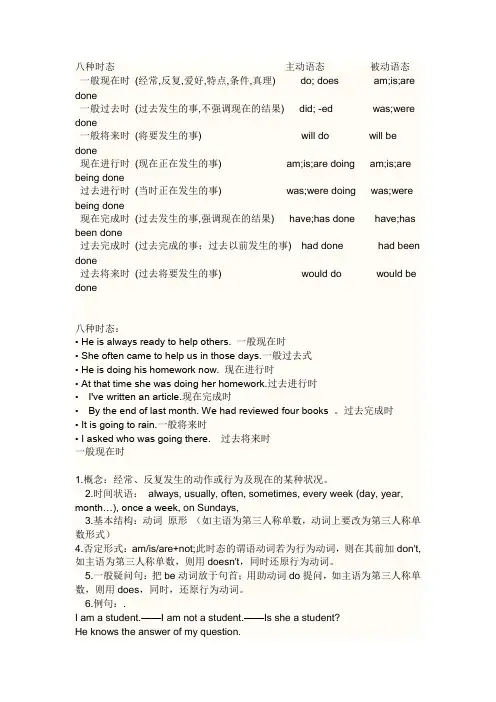
八种时态主动语态被动语态一般现在时(经常,反复,爱好,特点,条件,真理) do; does am;is;are done一般过去时(过去发生的事,不强调现在的结果) did; -ed was;were done一般将来时(将要发生的事) will do will be done现在进行时(现在正在发生的事) am;is;are doing am;is;are being done过去进行时(当时正在发生的事) was;were doing was;were being done现在完成时(过去发生的事,强调现在的结果) have;has done have;has been done过去完成时(过去完成的事;过去以前发生的事) had done had been done过去将来时(过去将要发生的事) would do would be done八种时态:• He is always ready to help others. 一般现在时• She often came to help us in those days.一般过去式• He is doing his homework now. 现在进行时• At that time she was doing her homework.过去进行时• I've written an article.现在完成时• By the end of last month. We had reviewed four books 。
过去完成时• It is going to rain.一般将来时• I asked who was going there. 过去将来时一般现在时1.概念:经常、反复发生的动作或行为及现在的某种状况。
2.时间状语:always, usually, often, sometimes, every week (day, year, month…), once a week, on Sundays,3.基本结构:动词原形(如主语为第三人称单数,动词上要改为第三人称单数形式)4.否定形式:am/is/are+not;此时态的谓语动词若为行为动词,则在其前加don't,如主语为第三人称单数,则用doesn't,同时还原行为动词。

八种时态主动语态被动语态一般现在时(经常,反复,爱好,特点,条件,真理) do; does am;is;are done一般过去时(过去发生的事,不强调现在的结果) did; -ed was;were done一般将来时(将要发生的事) will do will be done现在进行时(现在正在发生的事) am;is;are doing am;is;are being done过去进行时(当时正在发生的事) was;were doing was;were being done现在完成时(过去发生的事,强调现在的结果) have;has done have;has been done过去完成时(过去完成的事;过去以前发生的事) had done had been done过去将来时(过去将要发生的事) would do would be done八种时态:• He is always ready to help others. 一般现在时• She often came to help us in those days.一般过去式• He is doing his homework now. 现在进行时• At that time she was doing her homework.过去进行时• I've written an article.现在完成时• By the end of last month. We had reviewed four books 。
过去完成时• It is going to rain.一般将来时• I asked who was going there. 过去将来时一般现在时1.概念:经常、反复发生的动作或行为及现在的某种状况。
2.时间状语:always, usually, often, sometimes, every week (day, year, month…), once a week, on Sundays,3.基本结构:动词原形(如主语为第三人称单数,动词上要改为第三人称单数形式)4.否定形式:am/is/are+not;此时态的谓语动词若为行为动词,则在其前加don't,如主语为第三人称单数,则用doesn't,同时还原行为动词。
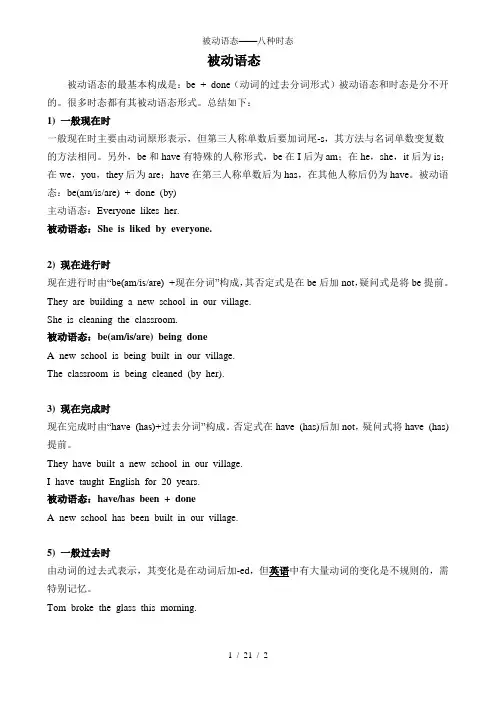
被动语态被动语态的最基本构成是:be + done(动词的过去分词形式)被动语态和时态是分不开的。
很多时态都有其被动语态形式。
总结如下:1) 一般现在时一般现在时主要由动词原形表示,但第三人称单数后要加词尾-s,其方法与名词单数变复数的方法相同。
另外,be和have有特殊的人称形式,be在I后为am;在he,she,it后为is;在we,you,they后为are;have在第三人称单数后为has,在其他人称后仍为have。
被动语态:be(am/is/are) + done (by)主动语态:Everyone likes her.被动语态:She is liked by everyone.2) 现在进行时现在进行时由“be(am/is/are) +现在分词”构成,其否定式是在be后加not,疑问式是将be提前。
They are building a new school in our village.She is cleaning the classroom.被动语态:be(am/is/are) being doneA new school is being built in our village.The classroom is being cleaned (by her).3) 现在完成时现在完成时由“have (has)+过去分词”构成。
否定式在have (has)后加not,疑问式将have (has)提前。
They have built a new school in our village.I have taught English for 20 years.被动语态:have/has been + doneA new school has been built in our village.5) 一般过去时由动词的过去式表示,其变化是在动词后加-ed,但英语中有大量动词的变化是不规则的,需特别记忆。
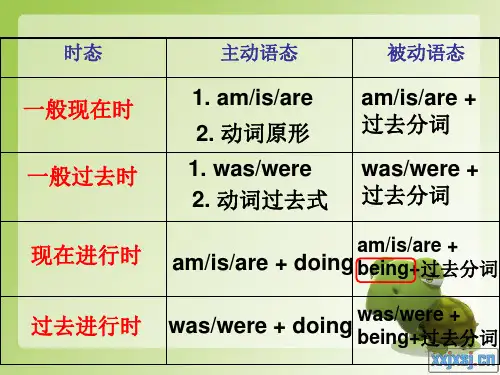
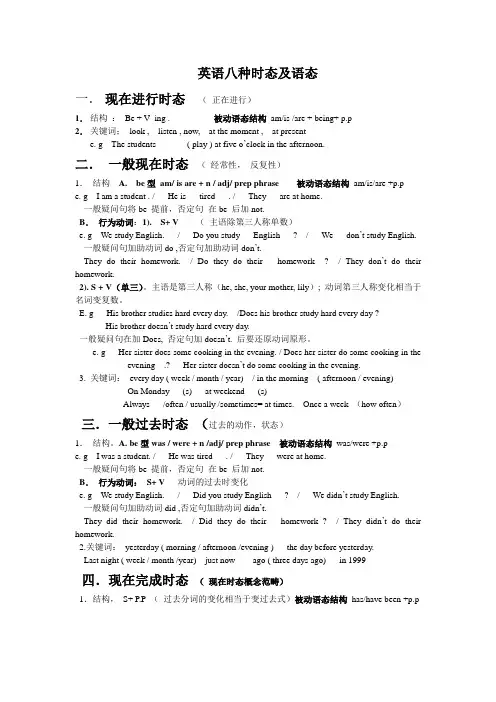
英语八种时态及语态一.现在进行时态(正在进行)1.结构:Be + V- ing . 被动语态结构am/is /are + being+ p.p2.关键词;look , listen , now, at the moment , at presente. g The students ----------( play ) at five o’clock in the afternoon.二.一般现在时态(经常性,反复性)1.结构 A. be型am/ is are + n / adj/ prep phrase被动语态结构am/is/are +p.pe. g I am a student . / He is tired . / They are at home.一般疑问句将be 提前,否定句在be 后加not.B.行为动词:1). S+ V (主语除第三人称单数)e. g We study English. / Do you study English ? / We don’t study English. 一般疑问句加助动词do ,否定句加助动词don’t.They do their homework. / Do they do their homework ? / They don’t do their homework.2). S + V(单三)。
主语是第三人称(he, she, your mother, lily); 动词第三人称变化相当于名词变复数。
E. g His brother studies hard every day. /Does his brother study hard every day ?His brother doesn’t study hard every day.一般疑问句在加Does, 否定句加doesn’t. 后要还原动词原形。
e. g Her sister does some cooking in the evening. / Does her sister do some cooking in theevening .? Her sister doesn’t do some cooking in the evening.3. 关键词:every day ( week / month / year) / in the morning ( afternoon / evening)On Monday (s) at weekend (s)Always /often / usually /sometimes= at times. Once a week (how often)三.一般过去时态(过去的动作,状态)1.结构。
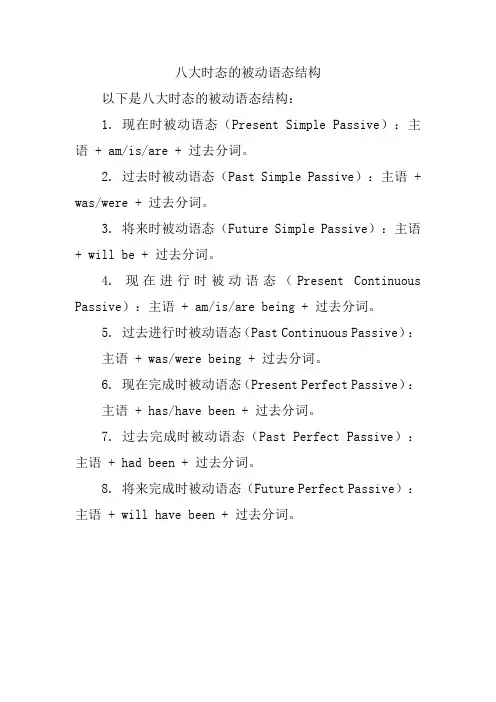
八大时态的被动语态结构
以下是八大时态的被动语态结构:
1. 现在时被动语态(Present Simple Passive):主语 + am/is/are + 过去分词。
2. 过去时被动语态(Past Simple Passive):主语 + was/were + 过去分词。
3. 将来时被动语态(Future Simple Passive):主语+ will be + 过去分词。
4. 现在进行时被动语态(Present Continuous Passive):主语 + am/is/are being + 过去分词。
5. 过去进行时被动语态(Past Continuous Passive):
主语 + was/were being + 过去分词。
6. 现在完成时被动语态(Present Perfect Passive):
主语 + has/have been + 过去分词。
7. 过去完成时被动语态(Past Perfect Passive):主语 + had been + 过去分词。
8. 将来完成时被动语态(Future Perfect Passive):主语 + will have been + 过去分词。

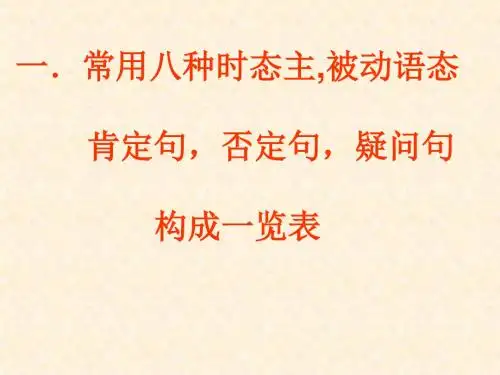
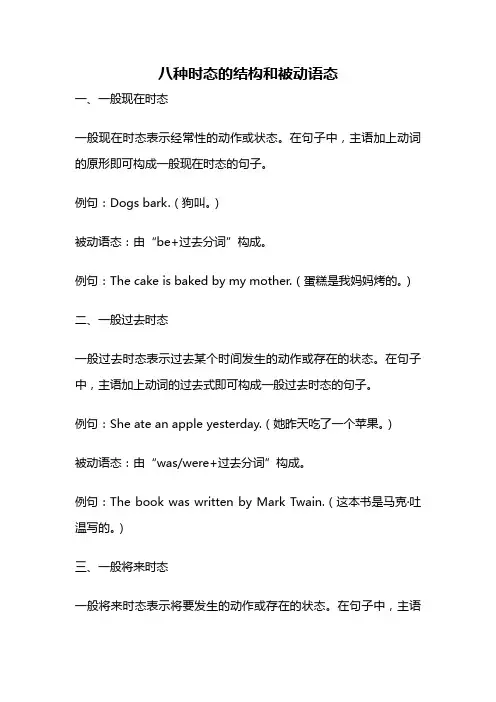
八种时态的结构和被动语态一、一般现在时态一般现在时态表示经常性的动作或状态。
在句子中,主语加上动词的原形即可构成一般现在时态的句子。
例句:Dogs bark.(狗叫。
)被动语态:由“be+过去分词”构成。
例句:The cake is baked by my mother.(蛋糕是我妈妈烤的。
)二、一般过去时态一般过去时态表示过去某个时间发生的动作或存在的状态。
在句子中,主语加上动词的过去式即可构成一般过去时态的句子。
例句:She ate an apple yesterday.(她昨天吃了一个苹果。
)被动语态:由“was/were+过去分词”构成。
例句:The book was written by Mark Twain.(这本书是马克·吐温写的。
)三、一般将来时态一般将来时态表示将要发生的动作或存在的状态。
在句子中,主语加上助动词“will”或“shall”,再加上动词的原形即可构成一般将来时态的句子。
例句:I will visit my grandparents next week.(我下周会去看望我的祖父母。
)被动语态:由“wil l be+过去分词”或“is/am/are going to be+过去分词”构成。
例句:The letter will be delivered by the postman.(这封信将由邮递员投递。
)四、现在进行时态现在进行时态表示现在正在进行的动作。
在句子中,主语加上“be”动词的现在分词形式,再加上动词的原形即可构成现在进行时态的句子。
例句:She is watching TV now.(她正在看电视。
)被动语态:由“am/is/are being+过去分词”构成。
例句:The house is being cleaned by the maid.(房子正在被女仆打扫。
)五、过去进行时态过去进行时态表示过去某个时间正在进行的动作。
在句子中,主语加上“was/were”动词的现在分词形式,再加上动词的原形即可构成过去进行时态的句子。
各种时态的被动语态一、八大时态的被动语态的构成:1.一般现在时的被动语态构成:(am/is/are +done)如:I am asked to study hard. 我被请求努力学习。
This shirt is washed once a week. 这件T恤一周洗一次。
These songs are usually sung by boys. 这些歌曲通常是男生唱的。
2.一般过去时的被动语态构成:(was/were done)如:The soldier was killed, but the train was saved. 这位战士牺牲了,然而列车得救了。
Some notes were passed up to the speaker. 有人给讲演者递上来一些纸条。
3.一般将来时的被动语态构成:(shall/will be done)如:We shall be asked a lot of strange questions. 我们将被问许多怪题。
My son will be sent to school next September. 来年九月我将送我儿子去读书。
4.过去将来时的被动语态构成:(should/would be done)如:The news would be sent to him as soon as it arrived. 消息一到就会转给他的。
He told us that the new railway would be built the next year. 他告诉我新铁路将在明年修建。
5.现在完成时的被动语态构成:(has/have been done)如:The work has just been finished. 工作刚刚结束。
The old rules have been done away with by us. 旧规章已经被我们废除了。
6.过去完成时的被动语态构成:(had been done)如:By last December three ships had been built by them. 到去年十二月底他们已建造了三艘船。
展宏学校中考英语常考八大时态与被动语态类别一般现在时现在进行时现在完成时一般将来时用途1.表示经常性、习惯性的动作;2.表示客观事实或永恒真理;3.表示特征、爱好、状态和能力等。
表示现在(说话瞬间) 正在进行或发生的动作。
1. 表示发生在过去的动作一直持续到现在; 2.表示发生在过去的动作对现在造成的影响或结果。
表示将来某个时间要发生的动作或存在的状态。
谓语结构(动词形式) V.原或V.三单(he/she/it或能够用he/she/it代替的人或物后用三单)am / is / are + V.-ing have/has + 过分 1.will + V.原2.be going to + V.原被动结构am / is / are + 过分am / is / are +being+过分have / has been + 过分will be + 过分时态标志1.频率副词:often; sometimes=(attimes); always; usually; every day(every + 时间)2. 次数:twice a week3.on Sundays:在每一个星期天例句:He often cleans the room. (主动)The room often by him.(被动)1. now = at present = rightnow = at the moment2. look, listen 开头的句子。
例句:She is watering the treesnow. (主动)The trees byher now. (被动)1. for / since+时间;2. 副词ever, never, yet,already等;3. so far = by now=up tonow;4. in the last/past fewyears;5. over the years= inrecent years1. 将来的时间:tomorrow;the dayafter tomorrow;next week ;in a fewdays;in 3 years;in the future ;thisevening/year/week2. at once=in a minute=right away3. soon例句:She will do it tomorrow. (主动)It by hertomorrow. (被动)易错小结在主从复合句中,当主句为一般将来时、主句为祈使句、主句含有情态动词时,从句必须用一般现在时。
精品资料欢迎下载英语八大时态及被动语态时态主动结构被动结构主动例句被动例句一般现在时do/does am/is/are+done We clean the classroom. The classroom is cleaned by us. 一般过去时did was/were+done He made a kite. The kite was made by him.一般将来时will be will be+done They will plant treestomorrow. The trees will be planted by them tomorrow.现在进行时am/is/are+doing am/is/are+being done She is watering flowers. The flowers are being watered by her.过去进行时was/were+doing was/were+being done She was writing a letter thistime yesterday. A letter was being written by her this time yesterday.现在完成时have/has+done have/has+been done Jim has finished the work. The work has been finished by Jim. 过去完成时had done had+ been done Jim had finished the work. The work had been finished by Jim. 过去将来时would do would be+done He said he would make a kite. He said a kite would be made by him.。
动词的语态:主动语态和被动语态被动语态的基本结构:Be + done(过去分词)1、一般现在时:(主动语态)I help you.发出者动词承受者变为被动语态:Do——am/is/are doneYou are helped by me.承受者谓语发出者2、一般过去时的被动:did——was/were done(I helped you.-每个例子可让学生自己先尝试变被动,再给答案)3、一般将来时的被动:Will do——will be done(I will help you.-)4、现在进行时的被动:Am/is/are doing ——Am/is/are being done(I am helping you.-)5、过去进行时的被动:Was/were doing——Was/were being done(I was helping you.-)6、现在完成时的被动:Have done——have been done (I have helped you.-)7、过去完成时的被动:Had done——had been done (I had helped you.-)8、过去将来时的被动:Would do ——would be done (I would help you.-)答案:2、You were helped by me.3、You will be helped by me.4、You are being helped by me.5、You were being helped by me.6、You have been helped by me.7、You had been helped by me.8、You would be helped by me.。
八大时态对照表八大时态及被动语态对照表常见英语过去式和过去分词规那么的动词begin 〔开始〕began begun drink 〔喝〕drank drunk ring 〔铃口向〕rang rung sing 〔唱〕sang sung swim 〔游泳〕swam swum blow 〔吹〕blew blown draw 〔画〕drew drawn fly 〔飞〕flew flowngrow 〔生长〕grew grownknow 〔知道〕knew knownthrow 〔投掷〕threw thrownshow 〔出示〕showed shownbreak 〔打破〕broke brokenchoose 〔选择〕chose chosenforget 〔忘十己〕forgot forgotten 〔forgot〕speak 〔说,讲〕spoke spokenwake 〔醒〕woke wokendrive 〔驾驶〕drove driveneat 〔吃〕ate eatenfall 〔落下〕fell fallen give 〔给〕gave given rise 〔升高〕rose risen take 〔取〕took taken mistake 〔弄夸昔〕mistook mistaken ride 〔骑〕rode ridden write 〔写〕wrote written do 〔做〕did donego 〔去〕went gonelie 〔平■躺〕lay lainsee 〔看见〕saw seenwear 〔穿〕wore worn不规那么的动词cost 〔花费〕cost costcut 〔割〕cut cuthit 〔打〕hit hithurt 〔伤害〕hurt hurtlet 〔让〕let letput 〔放〕put putread 〔读〕read read〔2〕AAB型〔动词原形与过去式同形〕beat 〔跳动〕beat beaten〔3〕ABA型〔动词原形与过去分词同形〕become 〔变成〕became becomecome 〔来〕came comerun 〔跑〕ran run⑷ABB型〔过去式与过去分词同形〕dig 〔挖〕dug dugget 〔得至U〕 got gothang 〔吊死〕hanged hangedhang 〔悬挂〕hung hunghold 〔抓住〕held heldshine 〔照耀〕shone shonesit 〔坐〕sat satwin 〔赢〕won wonmeet 〔遇见〕met metkeep 〔保持〕kept kept sleep 〔睡〕slept slept sweep 〔扫〕swept sweptfeel 〔感觉〕felt feltsmell 〔闻〕smelt smelt leave 〔离开〕left left build 〔建设〕built built lend 〔借出〕lent lent send 〔传送〕sent sentspend 〔花费〕spent spentlose 〔丧失〕lost lost burn 〔燃烧〕burnt burnt learn 〔学习〕learnt learnt sell 〔卖〕sold sold tell 〔告诉〕told toldmean 〔意思〕meant meantcatch 〔抓住〕caught caughtteach 〔教〕taught taught bring 〔带来〕brought brought fight 〔战斗〕fought foughtbuy 〔买〕bought boughtthink 〔想〕thought thoughthear 〔听见〕heard heardsay 〔说〕said saidfind 〔找到〕found foundhave/has 〔有〕had hadmake 〔制造〕made madestand 〔站〕stood stoodunderstand 〔明白〕understood understood。